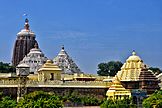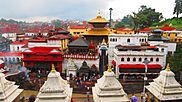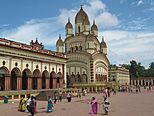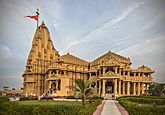Mandir facts for kids
A Hindu temple, also known as a Mandir, is a sacred place where Hindus go to worship and show their devotion to their gods and goddesses. It is seen as the home of the god or goddess it is built for.
Hindu temples come in many different styles and are found all over the world. They are in countries like India, Nepal, Bangladesh, Sri Lanka, and many places in Southeast Asia such as Cambodia and Indonesia. You can also find them in countries like Canada, the United States, the United Kingdom, Australia, and many others where Hindus live. The way temples look today shows how art and building methods have changed over thousands of years. The Swaminarayan Akshardham in Robbinsville, New Jersey, opened in 2014, is one of the largest Hindu temples outside Asia.
Contents
Why are Hindu temples important?
Hindus believe that gods and goddesses listen to prayers and offer spiritual guidance. Temples are seen as a special connection point between people and the divine. Many believe that visiting a temple can help wishes come true and offer protection.
What do Hindu temples look like?
Most Hindu temples are designed in one of two ways: like a house or like a palace. A house-themed temple is a simple place that acts as a home for the deity. People visit these temples just like they would visit a friend or family member.
In some Hindu traditions, temples are places for puja. This is a special ritual where the deity is honored, and people connect with them. In other traditions, people might simply meditate, practice yoga, or reflect quietly in the temple. Palace-themed temples often have much grander and more detailed architecture.
Where are Hindu temples built?
Hindu temples are built in many different kinds of places, each with unique building styles:
- Mountain temples: Found high up in mountains, like the Masrur Temples.
- Cave temples: Carved directly into caves, such as the famous Ellora Caves.
- Stepwell temples: Part of large stepwell complexes, like Mata Bhavani's Stepwell.
- Forest temples: Hidden away in natural forests.
- River and seashore temples: Located by rivers or the sea, like the Somnath temple.
Temples built into stepwells
In dry western parts of India, like Rajasthan and Gujarat, Hindu communities built large walk-in wells. These wells were the only source of water during dry seasons. They also served as important social gathering places and had religious meaning. These amazing structures went deep into the earth, sometimes seven stories down. They were often part of a larger temple complex.
These stepwells, called vav, had beautiful carvings on their walls. They featured many images of Hindu deities and water spirits. Some stepwells were named after Hindu gods and goddesses, like Mata Bhavani's Stepwell. These stepwells and their temples were built over a long period, from ancient times up to the 11th century CE. One famous example, Rani ki vav, has hundreds of detailed carvings, including many of the god Vishnu's forms. It is now a UNESCO World Heritage Site.
Temples carved from rock
In India, especially in Maharashtra, a unique style of temple building developed. Temples were carved out of a single large rock, either as a complete temple or as a cave designed to look like the inside of a temple. The Ellora Caves are an example of a temple carved from one piece of rock. The Elephanta Caves show the style where caves were made to look like temple interiors. The Elephanta Caves have five large Hindu caves dedicated to the god Shiva, along with two smaller Buddhist caves.
Images for kids
-
A Mandir in Slemmestad, Norway, belonging to the biggest Hindu community there.
-
A Mandir in Angkor Wat, Cambodia, which later became a Buddhist Temple.
-
Mandir at Mysore Palace, Southern India.
-
The Golden Temple at Vellore is covered with 1500 kg of pure gold.
-
Dakshineswar Kali Temple, Kolkata.
-
An aerial view of the Meenakshi Temple in Madurai, built by the Pandyan Empire.
-
Pashupatinath Temple from the Bagmati river, Kathmandu, Nepal.
-
The Prambanan temple complex in Yogyakarta, the largest Hindu temple in Indonesia.
-
The 5th-century Ladkhan Shiva Temple, in the Aihole Hindu-Jain-Buddhist temple site, in Karnataka.
-
Plan of 5th-century temples in Eran, Madhya Pradesh.
-
The Somnath temple in Gujarat was damaged and rebuilt many times. This picture shows it in 1869, before its modern reconstruction in the 1950s.
-
The Ganesh temple of Hindu Temple Society of North America in Flushing, New York City, is the oldest Hindu temple in the Western hemisphere.
-
Swaminarayan Akshardham in Robbinsville, New Jersey, U.S., is the largest Hindu temple in the Western hemisphere.
See also
 In Spanish: Mandir para niños
In Spanish: Mandir para niños






















































